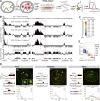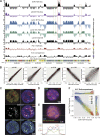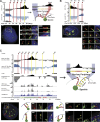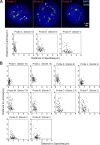Mapping 3D genome organization relative to nuclear compartments using TSA-Seq as a cytological ruler
- PMID: 30154186
- PMCID: PMC6219710
- DOI: 10.1083/jcb.201807108
Mapping 3D genome organization relative to nuclear compartments using TSA-Seq as a cytological ruler
Abstract
While nuclear compartmentalization is an essential feature of three-dimensional genome organization, no genomic method exists for measuring chromosome distances to defined nuclear structures. In this study, we describe TSA-Seq, a new mapping method capable of providing a "cytological ruler" for estimating mean chromosomal distances from nuclear speckles genome-wide and for predicting several Mbp chromosome trajectories between nuclear compartments without sophisticated computational modeling. Ensemble-averaged results in K562 cells reveal a clear nuclear lamina to speckle axis correlated with a striking spatial gradient in genome activity. This gradient represents a convolution of multiple spatially separated nuclear domains including two types of transcription "hot zones." Transcription hot zones protruding furthest into the nuclear interior and positioning deterministically very close to nuclear speckles have higher numbers of total genes, the most highly expressed genes, housekeeping genes, genes with low transcriptional pausing, and super-enhancers. Our results demonstrate the capability of TSA-Seq for genome-wide mapping of nuclear structure and suggest a new model for spatial organization of transcription and gene expression.
© 2018 Chen et al.
Figures











References
Publication types
MeSH terms
Grants and funding
LinkOut - more resources
Full Text Sources
Other Literature Sources
Molecular Biology Databases
Research Materials
Miscellaneous

